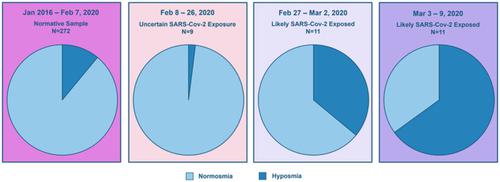当前位置:
X-MOL 学术
›
Eur. J. Nerosci.
›
论文详情
Our official English website, www.x-mol.net, welcomes your feedback! (Note: you will need to create a separate account there.)
Impairments in odour detection and hedonic ratings of unpleasant smells in asymptomatic university students as SARS-Cov-2 emerged locally
European Journal of Neroscience ( IF 3.4 ) Pub Date : 2021-08-23 , DOI: 10.1111/ejn.15430 Julie Walsh‐Messinger 1, 2 , Sahar Kaouk 1 , Hannah Manis 1 , Rachel Kaye 3 , Guillermo Cecchi 4 , Pablo Meyer 4 , Dolores Malaspina 5
European Journal of Neroscience ( IF 3.4 ) Pub Date : 2021-08-23 , DOI: 10.1111/ejn.15430 Julie Walsh‐Messinger 1, 2 , Sahar Kaouk 1 , Hannah Manis 1 , Rachel Kaye 3 , Guillermo Cecchi 4 , Pablo Meyer 4 , Dolores Malaspina 5
Affiliation

|
Sudden olfactory loss in the absence of concurrent nasal congestion is now a well-recognized symptom of COVID-19. We examined olfaction using standardized objective tests of odour detection, identification and hedonics collected from asymptomatic university students before and as SARS-CoV-2 emerged locally. Olfactory performance of students who were tested when the virus is known to be endemic (n = 22) was compared to students tested in the month prior to viral circulation (n = 25), a normative sample assessed during the previous 4 years (n = 272) and those tested in prior years during the same time period. Analyses showed significantly reduced odour detection for the virus exposed cohort compared to students tested before (t = 2.60; P = .01; d = 0.77; CI 0.17, 1.36) and to the normative sample (D = 0.38; P = .005). Odour identification scores were similar, but the exposed cohort rated odours as less unpleasant (P < .001, CLES = 0.77). Hyposmia increased 4.4-fold for students tested 2 weeks before school closure (N = 22) and increased 13.6-fold for students tested in the final week (N = 11). While the unavailability of COVID-19 testing is a limitation, this naturalistic study demonstrates week-by-week increase in hyposmia in asymptomatic students as a virus was circulating on campus, consistent with increasing airborne viral loads. The specific hedonic deficit in unpleasantness appraisal suggests a deficit in the TAAR olfactory receptor class, which conveys the social salience of odours. Assessment of odour detection and hedonic ratings may aid in early detection of SARS-CoV-2 exposure in asymptomatic and pre-symptomatic persons.
中文翻译:

由于 SARS-Cov-2 在当地出现,无症状大学生的气味检测和难闻气味的享乐评分受损
在没有并发鼻塞的情况下突然嗅觉丧失现在是 COVID-19 公认的症状。我们使用从无症状大学生身上收集的气味检测、识别和享乐的标准化客观测试来检查嗅觉,这些测试是在 SARS-CoV-2 在当地出现之前和之后出现的。将已知病毒流行时接受测试的学生的嗅觉表现 ( n = 22) 与病毒传播前一个月接受测试的学生 ( n = 25) 进行比较,这是过去 4 年评估的规范样本 ( n = 272)和前几年在同一时间段内进行的测试。分析表明,与之前接受测试的学生相比,病毒暴露组的气味检测显着减少(t = 2.60; P = .01;d = 0.77;CI 0.17, 1.36)和标准样本(D = 0.38;P = .005)。气味识别评分相似,但暴露组认为气味不太令人不快(P < .001,CLES = 0.77)。在学校关闭前 2 周(N = 22)接受测试的学生,嗅觉减退增加了 4.4 倍,而在最后一周接受测试的学生(N = 11)。虽然无法进行 COVID-19 检测是一个限制,但这项自然主义研究表明,随着病毒在校园内传播,无症状学生的嗅觉减退症每周都在增加,这与空气传播的病毒载量增加一致。不愉快评估中的特定享乐缺陷表明 TAAR 嗅觉受体类的缺陷,它传达了气味的社会显着性。气味检测和快感评级的评估可能有助于早期发现无症状和有症状的人的 SARS-CoV-2 暴露。
更新日期:2021-09-21
中文翻译:

由于 SARS-Cov-2 在当地出现,无症状大学生的气味检测和难闻气味的享乐评分受损
在没有并发鼻塞的情况下突然嗅觉丧失现在是 COVID-19 公认的症状。我们使用从无症状大学生身上收集的气味检测、识别和享乐的标准化客观测试来检查嗅觉,这些测试是在 SARS-CoV-2 在当地出现之前和之后出现的。将已知病毒流行时接受测试的学生的嗅觉表现 ( n = 22) 与病毒传播前一个月接受测试的学生 ( n = 25) 进行比较,这是过去 4 年评估的规范样本 ( n = 272)和前几年在同一时间段内进行的测试。分析表明,与之前接受测试的学生相比,病毒暴露组的气味检测显着减少(t = 2.60; P = .01;d = 0.77;CI 0.17, 1.36)和标准样本(D = 0.38;P = .005)。气味识别评分相似,但暴露组认为气味不太令人不快(P < .001,CLES = 0.77)。在学校关闭前 2 周(N = 22)接受测试的学生,嗅觉减退增加了 4.4 倍,而在最后一周接受测试的学生(N = 11)。虽然无法进行 COVID-19 检测是一个限制,但这项自然主义研究表明,随着病毒在校园内传播,无症状学生的嗅觉减退症每周都在增加,这与空气传播的病毒载量增加一致。不愉快评估中的特定享乐缺陷表明 TAAR 嗅觉受体类的缺陷,它传达了气味的社会显着性。气味检测和快感评级的评估可能有助于早期发现无症状和有症状的人的 SARS-CoV-2 暴露。


























 京公网安备 11010802027423号
京公网安备 11010802027423号